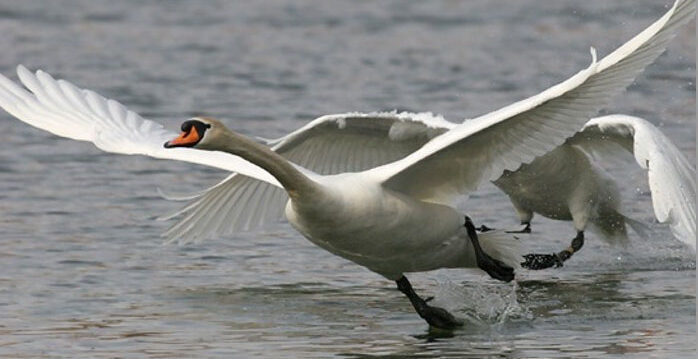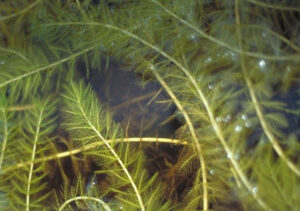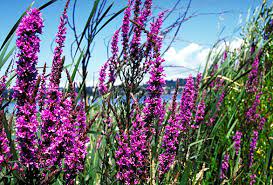On August 13, 2009, Governor Mitch Daniels signed into law, legislation creating the state Invasive Species Council.
This action was based on the recommendation of a task force established by a joint House and Senate committee.
Click on the graphic to read a report issued by the Indiana Invasive Species Council.

Mute swans (Cygnus olor) are an invasive species that have become established in high numbers on many bodies of water in Indiana. They can damage our aquatic and wetland ecosystems while acting aggressively toward people, pets, and native wildlife. However, many people are unaware of the problems mute swans cause but are instead drawn to them because they are a charismatic and beautiful large bird.
The mute swan is native throughout much of Eurasia. It was introduced into the United States in the late 19th century. The species now occupies a large part of the country with the largest populations found around the Great Lakes region and the Atlantic coast.
Because mute swans are not native to the United States, federal protection for the species under the Migratory Bird Treaty Reform Act was removed in 2004. In Indiana, however, mute swans are currently regulated, and a permit from Indiana DNR is required to disturb eggs or to capture or legally take a mute swan, unless it is on property that you own or lease. Live mute swans may be kept as pets, bred in captivity, and sold without a permit from the DNR, but must be pinioned (i.e., made flightless) and kept in an enclosure that prevents their escape into the wild.

Courtesy The Trumpeter Swan Society
There are three species of swans that can be found in Indiana. At this time, the mute swan is the most abundant swan in Indiana and can commonly be found year-round, except perhaps during the harshest winter weather. Less abundant are native trumpeter and tundra swans. Trumpeter swans are a state endangered species that have seen recent breeding success in some northern Indiana counties. Ohio had a considerable increase of trumpeter swans along Lake Erie after aggressive management and removal of mute swans. Tundra swans breed in remote Arctic areas and pass through Indiana during fall migration to their wintering grounds along the mid-Atlantic coast.
All three species have bright white plumage as adults. The easiest way to differentiate mute swans from the other two species is that adult mute swans have an orange beak with a black border near their eyes and a black knob atop their beak. Trumpeter and tundra swans have beaks that are completely black.

As the mute swan population has greatly expanded over the last few decades, so has the destruction of habitats attributed to their presence. An adult mute swan consumes up to eight pounds of aquatic and wetland vegetation per day. In addition, they uproot significantly more vegetation than they eat, some of which can wash ashore and create an unsightly mess for shoreline residents to clean up. During nest building, they can destroy large areas of wetland vegetation. These disturbances can have a serious impact on water quality, aquatic habitat for fish and wildlife, and wetland functions. Major disturbance commonly leads to invasive species establishment. Mute swan feeding can reduce the available food sources that winter waterfowl and native birds require.
Mute swans are one of the world’s most aggressive waterfowl species and injure, kill, or displace native birds and other waterfowl. Adult mute swans may become especially aggressive toward people and pets in areas where they have become accustomed to food handouts. During the nesting season and rearing of young, mute swans have been known to aggressively drive off people and pets that enter their territory and have even knocked people from their boat and drowned them.
The invasive mute swan and its destructive impacts to native ecosystems can negatively affect other swan species. A trumpeter swan reintroduction program has been ongoing for more than 20 years in Ohio’s portion of Lake Erie. Establishment of trumpeter swans was slow until Ohio implemented its Swan Management Plan, which called for the removal of mute swans from public wildlife areas. The response was a strong increase in endangered trumpeter swan numbers. Trumpeter swan numbers have increased so much that the species is no longer a threatened species in Ohio.
Mute swans, notably, are not the solution to Canada goose conflicts. While swans may keep geese at a distance, especially during periods of nesting and rearing of young, they will not drive geese away from waters, except for perhaps at a small farm pond. In fact, mute swans may push more geese onto lawns around waters where there is already an extensive amount of conflict between the geese and property owners.

Myriophyllum spicatum L. Water-milfoil family (Haloragaceae
NATIVE RANGE
Eurasia and Africa
DESCRIPTION
Eurasian watermilfoil, also called spike watermilfoil, is an emergent,herbaceous aquatic plant. Stems grow to the water surface, usually extending 3 to 10, but as much as 33, feet in length and frequently forming dense mats. Stems of Eurasian milfoil are long, slender, branching, hairless, and become
leafless toward the base. New plants may emerge from each node (joint) on a stem, and root upon contact with mud. The grayish-green leaves of Eurasian watermilfoil are finely divided and occur in whorls of three or four along the stem, with 12-16 pairs of fine, thin leaflets about 1/2 inch long. These leaflets give milfoil a feathery appearance that is a distinguishing feature of the plant. Eurasian watermilfoil produces small yellow, 4-parted flowers on a spike that projects 2-
4 inches above the water surface. The fruit is a hard, segmented capsule containing four seeds.
ECOLOGICAL THREAT
Eurasian milfoil can form large, floating mats of vegetation on the surface of lakes, rivers, and other water bodies, preventing light penetration for native aquatic plants and impeding water traffic. The plant thrives in areas that have been subjected to various kinds of natural and manmade disturbance.
DISTRIBUTION IN THE UNITED STATES
Watermilfoil occurs in thirty-three states east of the Mississippi River and has recently been found in Colorado. It is abundant in the Chesapeake Bay, the tidal Potomac River, and several Tennessee Valley reservoirs.
HABITAT IN THE UNITED STATES
Typical habitat for Eurasian watermilfoil includes fresh to brackish water of fish ponds, lakes, slow-moving streams, reservoirs, estuaries, and canals. It is tolerant of many water pollutants. Eurasian watermilfoil tends to invade disturbed areas where native plants cannot adapt to the alteration. It does not spread rapidly into undisturbed areas where native plants are well established.
By altering waterways, humans have created a new and unnatural niche where milfoil thrives.
BACKGROUND
Eurasian watermilfoil was accidentally introduced from Eurasia in the 1940s. Two theories exist as to how it entered North America: (1) it escaped from an aquarium, or (2) it was brought in attached to commercial or private boats. A resort owner is thought to have introduced watermilfoil into the Tennessee Valley Authority reservoir system in 1953.
BIOLOGY & SPREAD
Most regeneration of Eurasian watermilfoil is from rhizomes, fragmented stems, and axillary buds that develop throughout the year. Flower spikes often remain above water until pollination is complete, then resubmerge. Although seeds are usually viable, they are not an important means of dispersal.
MANAGEMENT OPTIONS
Large harvesting equipment can be used to mechanically remove milfoil in larger areas; a sturdy hand-rake can be used for smaller areas. Other available options include manipulation of water level, light penetration and chemical control.
Potential impacts to existing native aquatic plant species should be evaluated carefully before implementing any of these techniques. For the single harvest, removal should take place just before peak biomass is obtained (early summer).
Substantial regrowth may occur if this is done too early. Better results appear with multiple harvests in the same growing season. If multiple harvests are not possible, then sustaining annual harvests is an option. All fragments of milfoil plants must be removed to achieve adequate control.
Where water levels are under manual control, raising or lowering of the water can be an effective way to reduce the growth of milfoil. By raising the water level, plants can be “drowned” by not having access to enough light. By lowering the water level, plants can be dehydrated and, at the right time of the year, frozen to death. This type of control is best used in conjunction with herbicides and shade barriers.
Bankside plantings, floating native plant species, light limiting dyes, or shade barriers are effective ways of reducing the amount of light reaching the plants and may reduce overall growth rates. Barriers can be used to prevent the movement and spread of aquatic weeds in ponds and lakes. A barrier is usually a suspended blocking screen that hangs vertically from a cable to a depth of about 4 meters; the cable is suspended by drum floats.
Fluridone (the active ingredient in Sonar® AS) is a selective herbicide for milfoil and several other exotic aquatic weeds.
There are no restrictions on swimming, fishing, or drinking after application, and season-long control can be achieved with one application. Fluridone is available in liquid or granular form and can be used as a spot treatment or on an entire waterway. For best results, applications should be made before or during the early stages of active growth.
USE PESTICIDES WISELY: Always read the entire pesticide label carefully, follow all mixing and application instructions and wear all recommended personal protective gear and clothing. Contact your state department of agriculture for any additional pesticide use requirements, restrictions or recommendations.
NOTICE: mention of pesticide products on this page does not constitute endorsement of any material.
CONTACT
For more information on the management of Eurasian watermilfoil, please contact:
• Kris Johnson, Great Smoky Mountains National Park, Gatlinburg, TN
• Al Cofrancesco, U.S. Army Corps of Engineers, cofrana at ex1.wes.army.mil
• Ken Langeland, University of Florida Institute of Food and Agriculture, kal at gnv.ifas.ufl.edu
• http://nas.er.usgs.gov/dicots/my_spica.html
• http://www.des.state.nh.us/wmb/exoticspecies/identify.htm
SUGGESTED ALTERNATIVE PLANTS
Yellow nelumbo (Nelumbo lutea), pond weed (Potamogeton nodosus), butterweed (Senecio glabellus) are some
alternative plants to consider for the eastern U.S.
OTHER LINKS
• http://www.invasive.org/search/action.cfm?q=Myriophyllum%20spicatum
• http://nbii-nin.ciesin.columbia.edu/ipane/icat/browse.do?specieId=78
AUTHORS
Tom Remaley, Great Smoky Mountains National Park, Gatlinburg, TN
EDITORS
Jil M. Swearingen, National Park Service, Washington, DC
Alison A. Dalsimer, Consultant, Legacy Resource Management Program, Washington, DC
PHOTOGRAPHS
Barry A. Rice, The Nature Conservancy, Davis, CA
REFERENCES
B.C. Ministry of Environment 1989. Eurasian Water Milfoil in British Columbia (Pamphlet).
Gleason, H.A., A. Cronquist. 1991. Manual of vascular plants of northeastern United States and adjacent Canada. 2nd ed. The New York Botanical Garden, 910.
Swearingen, J. 2009. WeedUS Database of Plants Invading Natural Areas in the United States: Eurasian Watermilfoil (Myriophyllum spicatum). http://www.invasive.org/weedus/subject.html?sub=3055.
USDA, NRCS. 2009. The PLANTS Database (http://plants.usda.gov). National Plant Data Center, Baton Rouge, LA 70874-4490 USA.

Lythrum salicaria L.
Loosestrife family (Lythraceae)
NATIVE RANGE
Eurasia; throughout Great Britain, and across central and southern Europe to central Russia, Japan, Manchuria China, southeast Asia and northern India
DESCRIPTION
Purple loosestrife is an erect perennial herb in the loosestrife family, with a square, woody stem and opposite or whorled leaves. Leaves are lance-shaped, stalkless, and heart-shaped or rounded at the base. Plants are usually covered by a downy pubescence. Loosestrife plants grow from four to ten feet high, depending upon conditions, and produce a showy display of magenta-colored flower spikes throughout much of the summer. Flowers have five to seven petals. Mature plants can have from 30 to 50 stems arising from a single rootstock.
ECOLOGICAL THREAT
Purple loosestrife adapts readily to natural and disturbed wetlands. As it establishes and expands, it outcompetes and replaces native grasses, sedges, and other flowering plants that provide a higher quality source of nutrition for wildlife. The highly invasive nature of purple loosestrife allows it to form dense, homogeneous stands that restrict native wetland plant species, including some
federally endangered orchids, and reduce habitat for waterfowl.
DISTRIBUTION IN THE UNITED STATES
According to the U.S. Fish and Wildlife Service, purple loosestrife now occurs in every state except Florida.
HABITAT IN THE UNITED STATES
Purple loosestrife is capable of invading many wetland types, including freshwater wet meadows, tidal and non-tidal marshes, river and stream banks, pond edges, reservoirs, and ditches.
BACKGROUND
Purple loosestrife was introduced to the northeastern U.S. and Canada in the 1800s, for ornamental and medicinal uses. It is still widely sold as an ornamental, except in states such as Minnesota, Wisconsin, and Illinois where regulations now prohibit its sale, purchase and distribution.
BIOLOGY & SPREAD
Purple loosestrife enjoys an extended flowering season, generally from June to September, which allows it to produce vast quantities of seed. The flowers require pollination by insects, for which it supplies an abundant source of nectar. A mature plant may have as many as thirty flowering stems capable of producing an estimated two to three million, minute seeds per year.
Purple loosestrife also readily reproduces vegetatively through underground stems at a rate of about one foot per year. Many new stems may emerge vegetatively from a single rootstock of the previous year. “Guaranteed sterile” cultivars of purple loosestrife are actually highly fertile and able to cross freely with purple loosestrife and with other native Lythrum species. Therefore, outside of its native range, purple loosestrife of any form should be avoided.
MANAGEMENT OPTIONS
Small infestations of young purple loosestrife plants may be pulled by hand, preferably before seed set. For older plants, spot treating with a glyphosate type herbicide (e.g., Rodeo® for wetlands, Roundup® for uplands) is recommended. These herbicides may be most effective when applied late in the season when plants are preparing for dormancy. However, it may be best to do a mid-summer and a late season treatment, to reduce the amount of seed produced. Biological While herbicides and hand removal may be useful for controlling individual plants or small populations, biological control is seen as the most likely candidate for effective long-term control of large infestations of purple loosestrife. As of 1997, three insect species from Europe have been approved by the U.S. Department of Agriculture for use as biological control agents. These plant-eating insects include a root-mining weevil (Hylobius transversovittatus), and two leaf-feeding beetles (Galerucella calmariensis and Galerucella pusilla). Two flower-feeding beetles (Nanophyes) that feed on various parts of purple loosestrife plants are still under investigation. Galerucella and Hylobius have been released experimentally in natural areas in 16 northern states, from Oregon to New York. Although these beetles have been observed occasionally feeding on native plant species, their potential impact to non-target species is considered to be low.
CONTACTS
For more information on the management of purple loosestrife, please contact:
• Cornell University Non-indigenous Plant Species Program, http://www.invasiveplants.net
• Virginia Natural Heritage Program. http://www.dcr.virginia.gov/dnh/invinfo.htm
SUGGESTED ALTERNATIVE PLANTS
Native species of Liatris (blazing star) have showy pink-purple flower spikes and are an important nectar source for many native species of butterflies and other insects.
OTHER LINKS
• http://www.invasive.org/search/action.cfm?q=Lythrum%20salicaria
• http://nbii-nin.ciesin.columbia.edu/ipane/icat/browse.do?specieId=72
AUTHOR
Jil M. Swearingen, National Park Service, Washington, DC
REFERENCES
Heidorn, R. and B. Anderson. 1991. Vegetation management guideline: purple loosestrife (Lythrum salicaria L.). Natural Areas Journal 11:172-173.
LaFleur, A. 1996. Invasive plant information sheet: purple loosestrife. The Nature Conservancy, Connecticut Chapter.
Malecki, R.A. (et al.). 1993. Biological control of purple loosestrife (Lythrum salicaria). BioScience 43 (10):680-686.
Swearingen, J. 2009. WeedUS Database of Plants Invading Natural Areas in the United States: Purple Loosestrife (Lythrum salicaria). http://www.invasive.org/weedus/subject.html?sub=3047.
The Nature Conservancy. Purple Loosestrife: Element Stewardship Abstract. In: Wildland Weeds Management & Research Program, Weeds on the Web.
Thompson, Daniel Q., Ronald L. Stuckey, Edith B. Thompson. 1987. Spread, Impact, and Control of Purple Loosestrife (Lythrum salicaria) in North American Wetlands. U.S. Fish and Wildlife Service. 55 pages.
USDA, NRCS. 2009. The PLANTS Database (http://plants.usda.gov). National Plant Data Center, Baton Rouge, LA 70874-4490 USA.
Virginia Department of Conservation and Natural Resources. 1995. Invasive Alien Plant Species of Virginia: Purple Loosestrife (Lythrum salicaria).